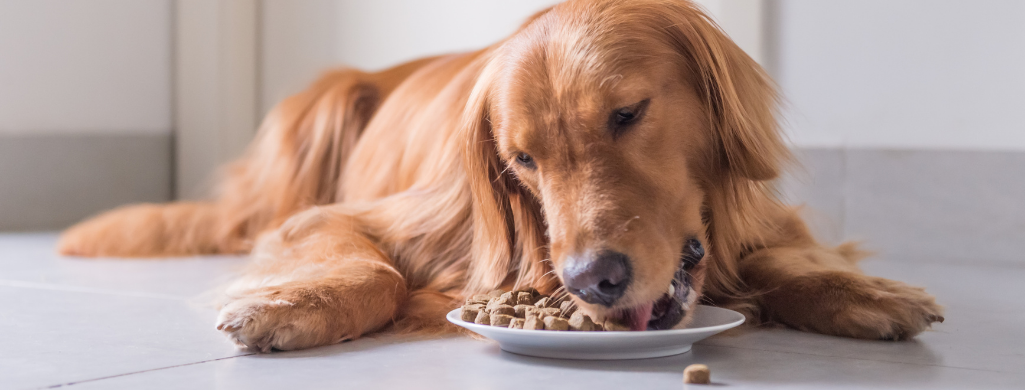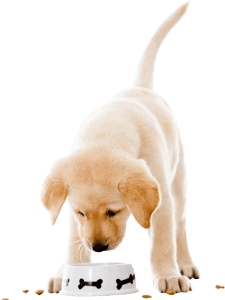
Neither wet nor dry food is definitely better. Each type of food has benefits and drawbacks.
As a Vet, I get this question a lot from new dog owners.
The subject of dog food, in particular, can sometimes be a minefield, starting from the basics: should I give my dog canned food or kibble?
If you look online, you’ll find a lot of different opinions on this topic. Unfortunately, many of them lack scientific credibility.
In this article, I’m going to give you my professional opinion as a qualified vet. I’ll explain which type of food is best for which situations.
Wet vs Dry Dog Food
So what is the difference between wet and dry dog food?
The first difference is implied in the name; wet food has more water content than kibble.
When making dry food, every measure is taken to reduce the food’s water activity to a point that will not allow microbial and fungal life to proliferate.
This is not necessary for canned food, because its long shelf-life is determined by the airtight packaging and temperatures during canning.
Wet food is usually found in tins, but other packing methods include sealed foil trays, plastic containers, and sachets.
According to the FEDIAF Nutritional Guidelines, pet food falls into 3 categories depending on its moisture content.
These are:
- Dry pet food with a moisture content of 14% or less.
- Semi-moist pet food with a moisture content of between 14% and 60%.
- Wet pet food with a moisture content of 60% or more.
Let’s take a closer look at the nutritional content of the canned and kibble versions of a particular chicken-based diet that is made by a particular brand:
| Nutrient | Dry Matter % (CANNED FOOD) | Dry Matter % (DRY KIBBLES) |
|---|---|---|
| Protein | 25.7 | 23.1 |
| Fat | 17.2 | 16.2 |
| Carbohydrate (NFE) | 50.2 | 53.8 |
| Crude fiber | 1.6 | 1.7 |
| Crude Ash | 5.3 | 5.1 |
| Vitamin A | 51855 IU/kg | 11605 IU/kg |
| Vitamin C | 115 ppm | 109 ppm |
| Vitamin D | 1399 IU/kg | 792 IU/kg |
| Vitamin E | 754 IU/kg | 655 IU/kg |
| Omega-3-fatty acids | 0.47 | 0.52 |
| Omega-6-fatty acids | 5.31 | 3.73 |
| Beta-carotene | 2.45 ppm | 3.10 ppm |
The contents of this table are derived from the wet and dry food variants of a specific diet produced by a major manufacturer. The name of the diet and manufacturer are not disclosed.
As you can see in the above comparison, dry dog food usually contains more carbohydrates and fewer proteins than wet food.
In this case, the differences are not drastic, as the manufacturer makes a lot of effort to maintain the uniformity of the various items in their product line.
However, the biggest difference between the two varieties is their vitamin content, with dog wet food being markedly richer in vitamins than its dry counterpart.
These differences stem from the different processes used to make the two formulations.
Differences between canned dog food and dry dog food can be more drastic when considering different manufacturers.
Some studies have reported an average crude protein (on a dry matter basis) of 40.8% in wet pet food and 31.4% in dry pet food.
Both diets have their own benefits and shortcomings, but as long as both are certified, complete diets and feeding instructions are closely followed, both canned food and kibble are certain to fulfill your dog’s minimum nutritional requirements.
Wet or Dry Dog Food? Which Is Better?
If wet dog food tends to be richer in protein and some vitamins, why should I still consider feeding dry dog food?
Firstly, dry food is more economical and easier to portion than wet food.
Dogs eating certain kibble varieties (particularly those with large kibble size) usually have better oral hygiene and healthier teeth and gums.
However, feeding your dog dry kibble will not absolve you from the responsibility of regularly brushing your dog’s teeth, taking your dog for dental checkups, and providing your dog with a daily (low calorie) dental chew stick.
Another advantage of dry foods is that it can be left in your dog’s food bowl for longer. This is particularly good for those dogs that graze throughout the day.
The dry nature of kibble will also stimulate your pet to drink more water keeping your dog hydrated while promoting their renal health.
It is not recommended to feed dry dog kibble as one big meal once a day (particularly to large, deep-chested dogs).
This is because the dry food may expand in your dog’s stomach causing bloat, which in turn can cause a life-threatening condition called Gastric Dilation and Volvulus.
Divide your dog’s dry kibble ration into two or more portions throughout the day to help avoid this.
If dry kibble is convenient, economical, better for my dog’s oral health while still meeting my dog’s requirements, why should I consider wet food?
Canned dog food is a great option for dogs who are picky eaters or those that suffer from tooth decay and gum disease.
The high protein, low carbohydrate nature of some wet foods also makes them good diets for diabetic dogs who benefit from low glycemic index diets.
Their high water content and low glycemic index make canned food a good option for dogs that need to lose some pounds.
As with everything, wet food comes with its own disadvantages. Wet food spoils much quicker than dry foods once open, due to its high water content and lack of preservatives.
It is not suggested to leave it in your pet’s bowl for more than a few hours as the food may have already been colonized by harmful microorganisms. Any unwanted food should be discarded.
Any freshly opened can containing unused food needs to be sealed with an airtight lid (e.g. reusable silicone lids) and can only be kept in the refrigerator for a maximum of 5 to 7 days.
Due to the high water content of these diets, generally, a higher volume of food is needed to satisfy the nutritional needs of your dog.
Puppies and dogs with small appetites can feel satiated before reaching their nutritional needs and can suffer from nutritional deficiencies.
Should I Choose Dry, Wet, or … Both?!
You should choose dry dog food if:
- You want a convenient, easily rationable diet.
- You want an economical diet.
- Your dog eats in small amounts throughout the day.
- You want to buy enough food for a few weeks while saving on space.
You should choose a wet dog food if:
- Your dog suffers from an oral disease or has difficulty chewing.
- Your dog suffers from obesity and you want to help them reduce weight without making them go hungry.
- Your dog is a finicky eater.
- Your dog doesn’t drink enough.
- You want a preservative-free or low preservative dog food.
Can I Mix Wet and Dry Dog Food?
Yes. You can have the best of both worlds by mixing both types of dog food. This can help dogs that find it difficult to eat a beneficial yet unpalatable dry diet.
If your dog is on a veterinary prescription diet we advise you to do this with caution. In such cases ask your veterinarian how you can best approach mixing wet and dry foods without compromising the prescription diet’s health benefits.
Reputable prescription dog food manufacturers often produce a wet and dry food version of the same product line. In such cases, we suggest you mix dry and wet dog food from the same product line.
The Bottom Line
We hope that the information above provides you with a clearer picture of how to tackle this often very perplexing dilemma.
Choosing whether to feed dry or wet food should be a decision based on what you find practical and on your dog’s needs and preferences.
We suggest you consult your veterinarian if you still feel unsure about how best to feed your dog.

